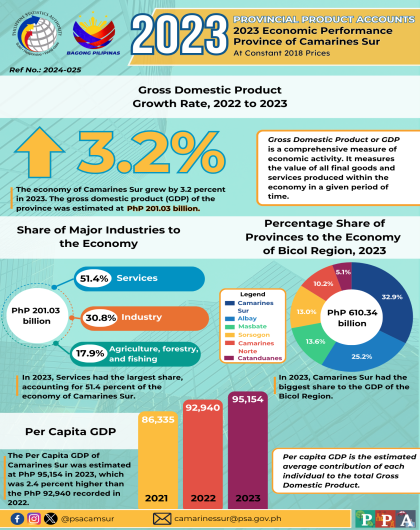The economy of Albay posted a growth of 6.8 percent in 2022, an acceleration from the
4.4 percent growth in the previous year. The Gross Domestic Product (GDP) of the province
was estimated at PhP 145.13 billion in 2022, an increase from PhP 135.94 billion in the
previous year. However, it remains lower than the pre-pandemic GDP level of
PhP 146.17 billion in 2019. (Figure 1)

In 2022, among the three major industries, Agriculture, forestry, and fishing rebounded from
8.2 percent decline in 2021 to 2.2 percent growth in 2022. Meanwhile, Industry decelerated to
3.5 percent in 2022, from 9.0 percent in the previous year. Within this industry sector, Mining
and quarrying, Manufacturing, and Construction slowed down, while Electricity, steam, water
and waste management declined. On the other hand, Services, accelerated to 9.8 percent, up
from the 4.1 percent growth in the previous year. Among Services, the fastest-growing
industries were Transportation and storage, Accommodation and food service activities, and
Information and Communication.
Transportation and storage, contributing 1.2 percentage points; Construction, contributing
1.2 percentage points; and Wholesale and retail trade; repair of motor vehicles and
motorcycles, contributing 0.3 percentage point were the leading contributors to the 6.8 percent
increase in the GDP of the province.


Construction accounted for the largest share in the economy of Albay at 15.7 percent, followed
by Wholesale and retail trade; repair of motor vehicles and motorcycles at 11.5 percent,
Manufacturing at 9.72 percent, Agriculture, forestry, and fishing at 9.70 percent, and Financial
and Insurance Activities at 9.4 percent. The shares of these industries already accounted for
more than half or 56.02 percent of the province’s GDP in 2022. (Figure 2)

The per capita GDP growth rate of Albay was recorded at 5.8 percent or estimated at
PhP 101.94 thousand in 2022. Per capita GDP represents the estimated average contribution
of each individual to the GDP of the province. (Figure 3)

In 2022, the economy of Bicol Region was estimated at 583.72 billion pesos. Camarines Sur
accounted for the largest share with 33.4 percent of the GDP of the region. Albay, ranked
second, with 24.9 percent share, followed by Masbate with 13.7 percent. Meanwhile,
Sorsogon had a share of 12.8 percent, Camarines Norte, with 10.3 percent, and Catanduanes,
with the least share of 4.9 percent.
The Philippine Statistics Authority (PSA) established through Republic Act No. 10625,
otherwise known as the Philippine Statistical Act of 2013, is tasked, among others, to compile
and maintain macroeconomic accounts and indicators, at the national and subnational level.
The Provincial Product Accounts or PPA is a mechanism to measure the economic
performance of provinces and highly urbanized cities (HUCs). The PPA compilation began in
2021, with three pilot regions, and expanded further to cover more ground as additional seven
regions were included in the compilation, including Region V. These seven regions compiled
the Gross Domestic Product of the provinces and HUCs for the period of 2018 to 2022. This
year, a total of 82 provinces and 17 HUCs are compiling their PPA.
Full data series, charts, and data visuals of PPA Bicol Region can be accessed at the PPA
landing page of the PSA (psa.gov.ph/statistics/ppa), and the PSA Regional website
(rsso05.psa.gov.ph/statistics/ppa).










